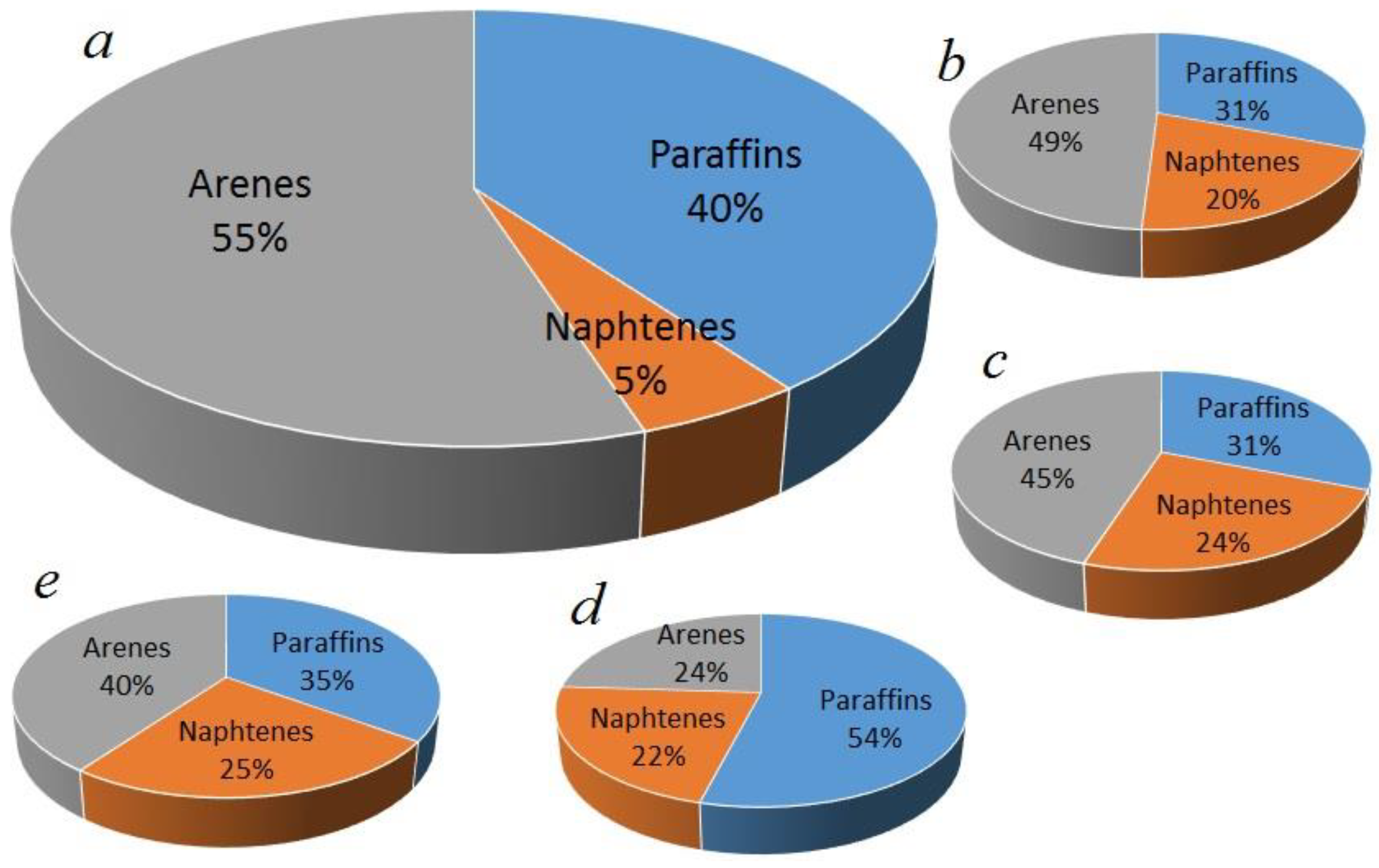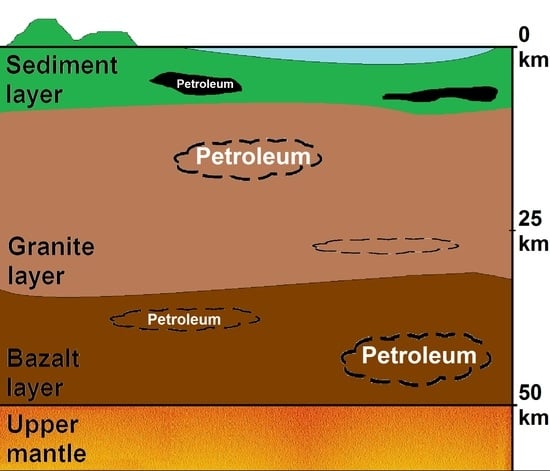Stability of a Petroleum-Like Hydrocarbon Mixture at Thermobaric Conditions That Correspond to Depths of 50 km
Abstract
:1. Introduction
2. Materials and Methods
2.1. Experimental Setup
2.2. Materials
3. Results
3.1. Thermal Stability of the Hydrocarbon System
3.2. The Oxidation Resistance of the Hydrocarbon System at the Thermobaric Conditions of Earth’s Crust
4. Discussion
Supplementary Materials
Author Contributions
Funding
Acknowledgments
Conflicts of Interest
References
- Kutcherov, V.G.; Krayushkin, V.A. Deep-Seated Abiogenic Origin of Petroleum: From Geological Assessment to Physical Theory. Rev. Geophys. 2010, 48, 1–30. [Google Scholar] [CrossRef]
- Langdon, S.P.; Connor, J.K.; Chandler, R.B.; Jellison, M.J. Deepwater Drilling Challenges Demonstrate Learning Curve with New Connection Technology. In IADC/SPE Drilling Conference and Exhibition; OnePetro: Richardson, TX, USA, 2010. [Google Scholar] [CrossRef]
- Kutcherov, V.; Kolesnikov, A. Hydrocarbon; InTech: London, UK, 2013. [Google Scholar] [CrossRef] [Green Version]
- Tissot, B.P.; Welte, D.H. Petroleum Formation and Occurrence; Springer Science & Business Media: Berlin/Heidelberg, Germany, 2013. [Google Scholar]
- Welte, D.H. Relation between petroleum and source rock. AAPG Bull. 1965, 49, 2246–2268. [Google Scholar]
- Vassoevich, N.B. Geochemistry of Organic Matter and Origin of Petroleum (in Russian); Nauka: Moscow, Russia, 1986; p. 368. [Google Scholar]
- Tissot, B.; Espitalié, J. L’evolution thermique de la matière organique des sédiments: Applications d’une simulation mathématique. Potentiel pétrolier des bassins sédimentaires de reconstitution de l’histoire thermique des sédiments. Rev. Inst. Fr. Pet. 1975, 30, 743–778. [Google Scholar] [CrossRef]
- Vandenbroucke, M.; Behar, F.; Rudkiewicz, J.L. Kinetic modelling of petroleum formation and cracking: Implications from the high pressure/high temperature Elgin Field (UK, North Sea). Org. Geochem. 1999, 30, 1105–1125. [Google Scholar] [CrossRef]
- Fort, J. The Elgin/Franklin Project: Developing the Largest High Pressure/High Temperature Fields in the World. In Proceedings of the Offshore Technology Conference, Houston, TX, USA, 1 January 2000; p. 8. [Google Scholar]
- Dominé, F.; Bounaceur, R.; Scacchi, G.; Marquaire, P.-M.; Dessort, D.; Pradier, B.; Brevart, O. Up to what temperature is petroleum stable? New insights from a 5200 free radical reactions model. Org. Geochem. 2002, 33, 1487–1499. [Google Scholar] [CrossRef] [Green Version]
- Savage, P.E.; Klein, M.T. Asphaltene reaction pathways. 2. Pyrolysis of n-pentadecylbenzene. Ind. Eng. Chem. Res. 1987, 26, 488–494. [Google Scholar] [CrossRef]
- Dominé, F. High pressure pyrolysis of n-hexane, 2,4-dimethylpentane and 1-phenylbutane. Is pressure an important geochemical parameter? Org. Geochem. 1991, 17, 619–634. [Google Scholar] [CrossRef]
- Behar, F.; Lorant, F.; Budzinski, H.; Desavis, E. Thermal stability of alkylaromatics in natural systems: Kinetics of thermal decomposition of dodecylbenzene. Energy Fuels 2002, 16, 831–841. [Google Scholar] [CrossRef]
- Burklé-Vitzthum, V.; Michels, R.; Scacchi, G.; Marquaire, P.-M.; Dessort, D.; Pradier, B.; Brevart, O. Kinetic effect of alkylaromatics on the thermal stability of hydrocarbons under geological conditions. Org. Geochem. 2004, 35, 3–31. [Google Scholar] [CrossRef]
- Frost, D.J.; McCammon, C.A. The redox state of Earth’s mantle. Annu. Rev. Earth Planet. Sci. 2008, 36, 389–420. [Google Scholar] [CrossRef]
- Trots, D.M.; Kurnosov, A.; Ballaran, T.B.; Tkachev, S.; Zhuravlev, K.; Prakapenka, V.; Berkowski, M.; Frost, D.J. The Sm:YAG primary fluorescence pressure scale. J. Geophys. Res. Solid Earth 2013, 118, 5805–5813. [Google Scholar] [CrossRef]
- Dewaele, A.; Datchi, F.; Loubeyre, P.; Mezouar, M. High pressure-high temperature equations of state of neon and diamond. Phys. Rev. B 2008, 77, 094106. [Google Scholar] [CrossRef]
- Cottrell, E.; Kelley, K.A. The oxidation state of Fe in MORB glasses and the oxygen fugacity of the upper mantle. Earth Planet. Sci. Lett. 2011, 305, 270–282. [Google Scholar] [CrossRef]
- Barker, C. Calculated Volume and Pressure Changes During the Thermal Cracking of Oil to Gas in Reservoirs (1). AAPG Bull. 1990, 74, 1254–1261. [Google Scholar]
- McCammon, C. The paradox of mantle redox. Science 2005, 308, 807. [Google Scholar] [CrossRef]
- Grigoriev, B.A.; Gerasimov, A.A.; Lanchakov, L.A. Thermophysaical Proparties and Phase Equilibrium of Gas-Condensates and Their Fractions; MEI: Moscow, Russia, 2007. [Google Scholar]
- Demidenko, K.A.; Barsukova, V.V.; Krylova, S.M. Crude Oil and Gas-Condensate of Russia; Demidenko, K.A., Ed.; Tuma Group: Moscow, Russia, 2000; Volume 1, p. 192. [Google Scholar]
- Balitsky, V.; Bondarenko, G.; Pironon, J.; Penteley, S.; Balitskaya, L.; Golunova, M.; Bublikova, T. The causes of vertical zonation in the distribution of hydrocarbons over the Earth’s interior: Experimental evidence of the cracking of crude oil in high-temperature water-hydrocarbon fluids. Russ. J. Phys. Chem. B 2014, 8, 901–918. [Google Scholar] [CrossRef]
- Balitsky, V.; Prokof’ev, V.Y.; Balitskaya, L.; Bublikova, T.; Pentelei, S. Experimental study of the interaction of mineral-forming hydrothermal solutions with oil and their joint migration. Petrology 2007, 15, 211–223. [Google Scholar] [CrossRef]
- Pollack, H.N.; Chapman, D.S. On the regional variation of heat flow, geotherms, and lithospheric thickness. Tectonophysics 1977, 38, 279–296. [Google Scholar] [CrossRef] [Green Version]
- Zubkov, V.S.; Karpov, I.K.; Bychinskii, V.A.; Stepanov, A.N. Thermodynamic model for the C-H system under elevated temperatures and pressures. Geochem. Int. 1997, 36, 85–90. [Google Scholar]
- Sephton, M.A.; Hazen, R.M. On the origins of deep hydrocarbons. Rev. Mineral. Geochem. 2013, 75, 449–465. [Google Scholar] [CrossRef] [Green Version]
- Kenney, J.F.; Kutcherov, V.A.; Bendeliani, N.A.; Alekseev, V.A. The evolution of multicomponent systems at high pressures: VI. The thermodynamic stability of the hydrogen-carbon system: The genesis of hydrocarbons and the origin of petroleum. Proc. Natl. Acad. Sci. USA 2002, 99, 10976–10981. [Google Scholar] [CrossRef] [PubMed] [Green Version]
- Kutcherov, V.G.; Kolesnikov, A.; Dyugheva, T.I.; Kulikova, L.F.; Nikolaev, N.N.; Sazanova, O.A.; Braghkin, V.V. Synthesis of complex hydrocarbon systems at temperatures and pressures corresponding to the Earth’s upper mantle conditions. Dokl. Phys. Chem. 2010, 433, 132–135. [Google Scholar] [CrossRef]
- Yin, S.; Dusseault, M.B.; Rothenburg, L. Thermal reservoir modeling in petroleum geomechanics. Int. J. Numer. Anal. Methods Geomech. 2009, 33, 449–485. [Google Scholar] [CrossRef]




| Experiment | Sample | Pressure (GPa) | Temperature (°C) | Corresponding Depth (km) | Exposure Time (h) |
|---|---|---|---|---|---|
| 1 | Synthetic hydrocarbon mixture | 0.7 | 320 | 20–30 | 3 |
| 2 | Synthetic hydrocarbon mixture | 1.2 | 420 | 30–40 | 3 |
| 3 | Synthetic hydrocarbon mixture | 1.4 | 450 | 40–50 | 12 |
| 4 | Synthetic hydrocarbon mixture + Fe2O3 | 1.4 | 450 | 40–50 | 12 |
© 2020 by the authors. Licensee MDPI, Basel, Switzerland. This article is an open access article distributed under the terms and conditions of the Creative Commons Attribution (CC BY) license (http://creativecommons.org/licenses/by/4.0/).
Share and Cite
Serovaiskii, A.; Dubrovinky, L.; Kutcherov, V. Stability of a Petroleum-Like Hydrocarbon Mixture at Thermobaric Conditions That Correspond to Depths of 50 km. Minerals 2020, 10, 355. https://doi.org/10.3390/min10040355
Serovaiskii A, Dubrovinky L, Kutcherov V. Stability of a Petroleum-Like Hydrocarbon Mixture at Thermobaric Conditions That Correspond to Depths of 50 km. Minerals. 2020; 10(4):355. https://doi.org/10.3390/min10040355
Chicago/Turabian StyleSerovaiskii, Aleksandr, Leonid Dubrovinky, and Vladimir Kutcherov. 2020. "Stability of a Petroleum-Like Hydrocarbon Mixture at Thermobaric Conditions That Correspond to Depths of 50 km" Minerals 10, no. 4: 355. https://doi.org/10.3390/min10040355
APA StyleSerovaiskii, A., Dubrovinky, L., & Kutcherov, V. (2020). Stability of a Petroleum-Like Hydrocarbon Mixture at Thermobaric Conditions That Correspond to Depths of 50 km. Minerals, 10(4), 355. https://doi.org/10.3390/min10040355








